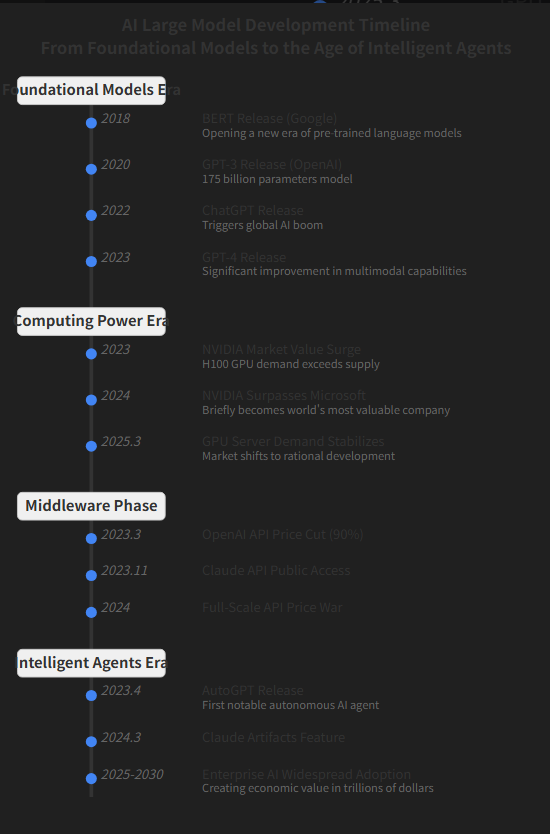
The development of AI large models is
undergoing an unprecedented transformation. From foundational models to today's
intelligent agent applications, the evolution of this field is both astonishing
and thought-provoking. Let us review this journey and look ahead to future
directions.
The Era of Foundational Large Models:
The Battle of Parameters
The first phase of large model development
was marked by the competition of foundational models, which has become a
"red ocean." Tech giants have invested massive resources in
developing models with increasingly larger parameter scales, more comprehensive
knowledge bases, and continuously improving performance.
Key milestones in this era:
- 2018: Google releases BERT, opening
a new chapter in pre-trained language models
- 2020: OpenAI launches GPT-3 with
groundbreaking 175 billion parameters, demonstrating "emergent
abilities" that come with scale
- 2022: ChatGPT triggers a global AI
boom by allowing average users to experience the power of large language
models
- 2023: GPT-4's release marks another
milestone with significantly enhanced multimodal capabilities
However, this phase of competition has
effectively excluded ordinary businesses and individuals. Training a
foundational large model requires hundreds of millions of dollars in funding,
top AI talent, and vast amounts of data—a game only giants like Microsoft,
Google, OpenAI, and Anthropic can afford to play.
The Era of Computational Power: Demand
Stabilizes
From 2023 to 2024, the training and
inference of large models triggered an unprecedented demand for computational
power.
Key developments in this era:
- 2023: NVIDIA's market value soars
as their H100 GPUs become scarce due to overwhelming demand
- 2024: NVIDIA briefly surpasses
Microsoft to become the world's most valuable company, reflecting extreme
market optimism about AI computing power
- March 2025: Demand for large
GPU-powered servers begins to stagnate, indicating sufficient
computational resources after two years of accumulation
This indicates that after two years of
accumulation, major companies now possess sufficient computational resources to
meet current needs, and the market is transitioning from rapid expansion to
rational development.
The Middleware Phase: API Integration
and Proliferation
With foundational models maturing, we are
entering a phase of flourishing middleware. Through API interfaces, developers
can leverage powerful AI capabilities without having to train models
themselves.
Significant events in this phase:
- March 2023: OpenAI slashes GPT-3.5
API prices by 90%, dramatically reducing the cost of AI application
development
- November 2023: Anthropic opens
access to their Claude 2.1 API, intensifying competition
- 2024: A full-scale API price war
erupts among major providers, making AI capabilities more accessible than
ever before
The focus of competition in this phase has
shifted from "who owns the most powerful model" to "who can
provide the most practical and cost-effective AI capabilities." These
price wars have significantly reduced the cost of AI applications and laid the
groundwork for the next stage of development.
The Development of General-Purpose
Intelligent Agents
Based on APIs, we are witnessing the rise
of intelligent agents. These agents are no longer simple model calls but
autonomous AI systems capable of planning, decision-making, and executing
tasks.
Notable milestones in this evolution:
- April 2023: Release of AutoGPT, the
first attention-grabbing autonomous AI agent demonstrating the ability to
plan and execute tasks independently
- March 2024: Claude's Artifacts
feature enhances AI's ability to generate complex documents and code
- May 2024: Release of GPT-4o
advances multimodal real-time interaction capabilities, making AI-human
interaction more natural and fluid
The emergence of intelligent agents enables
AI to shift from passive responses to proactive services. They can understand
more complex contexts, complete coherent multi-step tasks, and provide users
with more comprehensive solutions.
Enterprise-Level Private Intelligent
Agents: The Era of AI Serving Humanity
In the future, we will see the widespread
application of enterprise-level private intelligent agents. These agents will
be tailored to specific business scenarios, integrating internal data and
knowledge to offer more precise, secure, and business-specific AI services.
Expected developments:
- 2025: Specialized intelligent
agents deployed across vertical industries such as healthcare, finance,
and education
- 2026-2030: Enterprise-level AI
applications projected to become ubiquitous, potentially generating
economic value in the tens of trillions of dollars
The arrival of this phase signifies that AI
technology is truly transitioning from laboratories and large internet
platforms to various industries, serving people's daily work and lives.
Traditional sectors like healthcare, education, finance, and manufacturing will
be revitalized by the application of AI intelligent agents.
From a market perspective, the potential of
enterprise-level AI applications is staggering. This is not merely a
technological iteration but a new industrial revolution comparable to steam
engines and electricity. AI will reshape the global productivity landscape,
enhance efficiency, and create unprecedented business models and job
opportunities.
In this revolution, competition among
nations will become increasingly intense. The country that can first master and
maturely apply AI technology will gain more initiative and leverage in future
international competition. This impacts not only economic strength but also
national security, technological independence, and cultural influence. As a
result, governments worldwide are introducing AI strategies, increasing
investments, cultivating talent, and building ecosystems to secure advantageous
positions in this race that will define the future.
Conclusion
The development of AI large models is
shifting from technology-driven to application-driven, from the game of a few
giants to the collective participation of society. While the development of
foundational models will remain dominated by major companies, opportunities for
innovation at the application level are open to all.
In the future, AI will no longer be an
advanced technology out of reach but a reliable assistant integrated into
everyone's work and life. The true AI era is not defined by who possesses the
most advanced technology but by how AI serves humanity and improves lives.
This AI revolution has only just begun. Let us look forward to the beautiful future AI will create for humanity!

